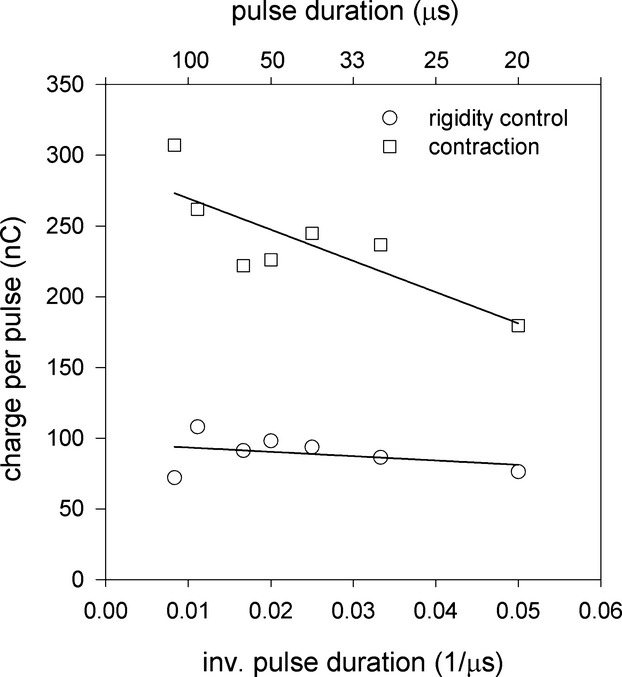Dear Editor,
We wish to comment on the assertion that a “short pulse width widens the therapeutic window of subthalamic neurostimulation,” as reported by Reich et al.1 In that publication, the authors defined “therapeutic window” in deep brain stimulation as the difference in current between the onset of full rigidity control and the onset of adverse muscle contractions at a given pulse duration. They determined such current differences experimentally for a number of pulse durations from 20–120 μsec in a small number of patients. The authors claimed that the larger current difference found at smaller pulse durations (shown in their Fig.1) is clinically advantageous. It is well established, however, that neither current amplitude nor pulse duration considered separately is an accurate predictor of electrically induced neural modulation or activity.2,3 A more justifiable first-order predictor is the charge conveyed by each pulse; that is, the product of current and pulse duration.4
Figure 1.

Strength–duration curves for rigidity control and muscle contraction replotted from Fig. 1A of Reich et al.1 The ordinate shows charge per pulse; that is, the product of current amplitude and pulse duration. The abscissa shows pulse duration (upper), whereas the lower scale shows the equivalent inverse pulse duration for direct comparison with the original Reich et al. figure.
We extracted the data of Reich et al. and replotted them in terms of charge per pulse. As shown in the accompanying figure, when those data are plotted using the same abscissa as in their Fig. 1A, the therapeutic window decreases for narrower pulses rather than increases as claimed previously.1 (The pulse durations are shown for clarity on the top axis.) The main reason for this contrasting observation is that relatively narrow pulses required less charge to produce adverse muscle contractions. Although the charge required for rigidity control appears to decrease slightly for narrower pulses, the fitted regression line has a slope that is not significantly different from zero. In general, it is more efficient for a given neural response to deliver charge using narrow rather than wide pulses, as noted in many previous reports.2,3 The fact that the data show almost constant charge per pulse for rigidity control may be partly a consequence of the restricted range of pulse durations used.
It remains unclear why Reich et al. defined therapeutic window in terms of current, but perhaps, it reflects the conventional programming of implantable pulse generators. In typical use of these stimulators, the pulse duration is selected first and then the current (or voltage) is adjusted while clinical effects are noted. However, the biophysics of neural stimulation suggests that charge per pulse is preferable as a measure of stimulus efficacy.4 With this interpretation, the experimental data actually show that wider pulses result in a larger therapeutic window.
Acknowledgments
This work was supported by the Colonial Foundation and the Victorian government's Operational Infrastructure Support program.
Conflict of Interest
None declared.
References
- Reich MM, Steigerwald F, Sawalheet AD, et al. Short pulse width widens the therapeutic window of subthalamic neurostimulation. Ann Clin Transl Neurol. 2015;2:427–432. doi: 10.1002/acn3.168. [DOI] [PMC free article] [PubMed] [Google Scholar]
- Ronner SF. Electrical excitation of CNS neurons. In: Agnew WF, McCreery DB, editors. Neural prostheses: fundamental studies. Englewood Cliffs: Prentice Hall; 1990. pp. 169–196. [Google Scholar]
- Merrill DR, Bikson M, Jefferys JG. Electrical stimulation of excitable tissue: design of efficacious and safe protocols. J Neurosci Methods. 2005;141:171–198. doi: 10.1016/j.jneumeth.2004.10.020. [DOI] [PubMed] [Google Scholar]
- Shepherd RK, Fallon JB, McDermott HJ. Medical bionics. In: Brahme A, editor. Comprehensive biomedical physics. Amsterdam: Elsevier; 2014. pp. 327–341. [Google Scholar]


